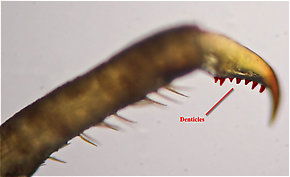Blog & Latest Updates
Fly Fishing Articles
Insects by Common Name


Insect Order Ephemeroptera (Mayflies)
Taxonomic Navigation -?-
Kingdom
Animalia (Animals)
» Phylum
Arthropoda (Arthropods)
» Class
Insecta (Insects)
» Order Ephemeroptera (Mayflies)
8 families aren't included.
Common Name
| Match | Common Name |
| Mayflies |
This is page 67 of specimens of Ephemeroptera. Visit the main Ephemeroptera page for:
- The behavior and habitat of Ephemeroptera.
- 67 underwater pictures of Ephemeroptera.
Pictures of 828 Mayfly Specimens:
Female Ephemerella invaria (Sulphur Dun) Mayfly Spinner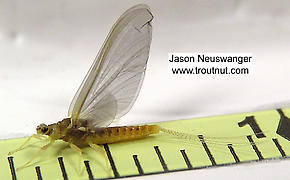 View 4 PicturesHere's the first sulphur dun I found in the 2004 season.
View 4 PicturesHere's the first sulphur dun I found in the 2004 season.
 View 4 PicturesHere's the first sulphur dun I found in the 2004 season.
View 4 PicturesHere's the first sulphur dun I found in the 2004 season.Collected May 18, 2004 from the Namekagon River in Wisconsin
Added to Troutnut.com by Troutnut on January 25, 2006
Added to Troutnut.com by Troutnut on January 25, 2006
Ephemerella aurivillii Mayfly Nymph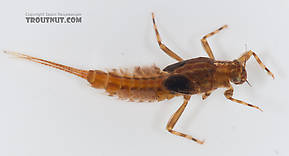 View 5 PicturesThis nymph hatched out in my aquarium into this dun.
View 5 PicturesThis nymph hatched out in my aquarium into this dun.
 View 5 PicturesThis nymph hatched out in my aquarium into this dun.
View 5 PicturesThis nymph hatched out in my aquarium into this dun.Female Maccaffertium (March Browns and Cahills) Mayfly Spinner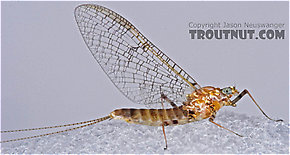 View 6 Pictures
View 6 Pictures
 View 6 Pictures
View 6 PicturesCollected July 1, 2005 from the Bois Brule River in Wisconsin
Added to Troutnut.com by Troutnut on April 22, 2006
Added to Troutnut.com by Troutnut on April 22, 2006
Female Drunella cornuta (Large Blue-Winged Olive) Mayfly Dun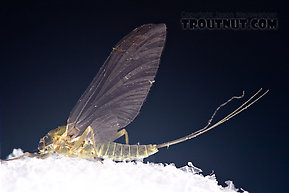 View 4 Pictures
View 4 Pictures
 View 4 Pictures
View 4 PicturesCollected May 29, 2007 from Brodhead Creek in Pennsylvania
Added to Troutnut.com by Troutnut on June 4, 2007
Added to Troutnut.com by Troutnut on June 4, 2007
Female Baetidae (Blue-Winged Olives) Mayfly Dun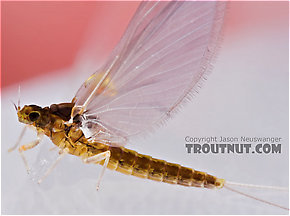 View 3 Pictures
View 3 Pictures
 View 3 Pictures
View 3 PicturesCollected May 28, 2005 from the Teal River in Wisconsin
Added to Troutnut.com by Troutnut on May 24, 2006
Added to Troutnut.com by Troutnut on May 24, 2006
Male Serratella micheneri (Little Western Dark Hendrickson) Mayfly Nymph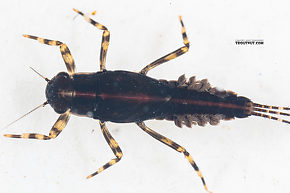 View 9 PicturesThis specimen has tarsal claws (Tarsal claw: The claws at the tip of the tarsus, on an insect's "foot.") with 7 denticles (Denticle: Small tooth-like projects, often appearing like serrations on the tarsal claws of certain mayfly nymphs.) and tubercles (
View 9 PicturesThis specimen has tarsal claws (Tarsal claw: The claws at the tip of the tarsus, on an insect's "foot.") with 7 denticles (Denticle: Small tooth-like projects, often appearing like serrations on the tarsal claws of certain mayfly nymphs.) and tubercles (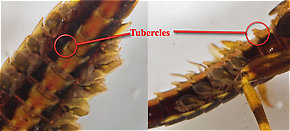 Tubercle: Various peculiar little bumps or projections on an insect. Their character is important for the identification of many kinds of insects, such as the nymphs of Ephemerellidae mayflies.) on abdominal segments 4-7 only. It keys to Serratella micheneri, as do some other specimens from the same collection that lacked the dorsal (Dorsal: Top.) stripe.
Tubercle: Various peculiar little bumps or projections on an insect. Their character is important for the identification of many kinds of insects, such as the nymphs of Ephemerellidae mayflies.) on abdominal segments 4-7 only. It keys to Serratella micheneri, as do some other specimens from the same collection that lacked the dorsal (Dorsal: Top.) stripe.
 View 9 PicturesThis specimen has tarsal claws (Tarsal claw: The claws at the tip of the tarsus, on an insect's "foot.") with 7 denticles (Denticle: Small tooth-like projects, often appearing like serrations on the tarsal claws of certain mayfly nymphs.) and tubercles (
View 9 PicturesThis specimen has tarsal claws (Tarsal claw: The claws at the tip of the tarsus, on an insect's "foot.") with 7 denticles (Denticle: Small tooth-like projects, often appearing like serrations on the tarsal claws of certain mayfly nymphs.) and tubercles (
A few (not all) of the abdominal tubercles on this Ephemerella needhami nymph are circled. They are especially large in this species.
Collected July 28, 2019 from Mystery Creek #199 in Washington
Added to Troutnut.com by Troutnut on July 30, 2019
Added to Troutnut.com by Troutnut on July 30, 2019
Siphloplecton basale (Pseudo-Gray Drake) Mayfly Nymph View 3 Pictures
View 3 Pictures
 View 3 Pictures
View 3 PicturesCollected March 10, 2004 from unknown in Wisconsin
Added to Troutnut.com by Troutnut on January 19, 2006
Added to Troutnut.com by Troutnut on January 19, 2006
Male Ephemerella excrucians (Pale Morning Dun) Mayfly Nymph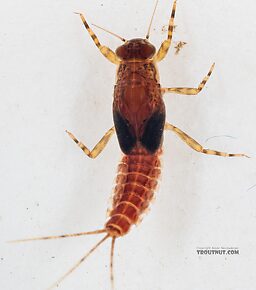 View 11 PicturesI used the ID of this nymph (and some others like it) to infer the identity of a female dun collected on the same trip.
View 11 PicturesI used the ID of this nymph (and some others like it) to infer the identity of a female dun collected on the same trip.
 View 11 PicturesI used the ID of this nymph (and some others like it) to infer the identity of a female dun collected on the same trip.
View 11 PicturesI used the ID of this nymph (and some others like it) to infer the identity of a female dun collected on the same trip.Collected July 4, 2020 from Mystery Creek #249 in Washington
Added to Troutnut.com by Troutnut on July 12, 2020
Added to Troutnut.com by Troutnut on July 12, 2020
Female Siphlonurus occidentalis (Gray Drake) Mayfly Spinner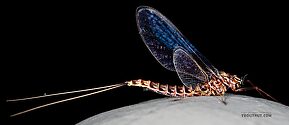 View 9 Pictures
View 9 Pictures
 View 9 Pictures
View 9 PicturesCollected July 31, 2020 from the Henry's Fork of the Snake River in Idaho
Added to Troutnut.com by Troutnut on August 16, 2020
Added to Troutnut.com by Troutnut on August 16, 2020
Ephemerella aurivillii Mayfly Nymph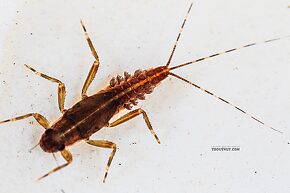 View 11 PicturesThis is a puzzling one to identify and I'm not sure about the species. The maxillary palp (
View 11 PicturesThis is a puzzling one to identify and I'm not sure about the species. The maxillary palp (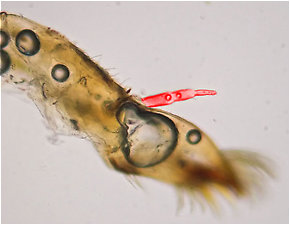 Palp: A long, thin, often segmented appendage which can protrude from certain insect mouth parts such as the maxillae. Also known as the < />palpus.) is present and segmented, and the maxillary canines are not strongly serrate laterally. I think it's Ephemerella, not Serratella. The ventral (Ventral: Toward or on the bottom.) lamellae of the gills on abdominal segment 6 have a clear median notch with a depth at least half the length of the lamellae, which points toward a couple of uncommon species (most likely Ephemerella alleni), but the abdominal tubercles (
Palp: A long, thin, often segmented appendage which can protrude from certain insect mouth parts such as the maxillae. Also known as the < />palpus.) is present and segmented, and the maxillary canines are not strongly serrate laterally. I think it's Ephemerella, not Serratella. The ventral (Ventral: Toward or on the bottom.) lamellae of the gills on abdominal segment 6 have a clear median notch with a depth at least half the length of the lamellae, which points toward a couple of uncommon species (most likely Ephemerella alleni), but the abdominal tubercles ( Tubercle: Various peculiar little bumps or projections on an insect. Their character is important for the identification of many kinds of insects, such as the nymphs of Ephemerellidae mayflies.) and coloration don't fit that species. To add to the confusion, none of the above species are expected to emerge in the fall, as far as I know. I'm going to call this one Ephemerella aurivillii for now, but that's highly uncertain.
Tubercle: Various peculiar little bumps or projections on an insect. Their character is important for the identification of many kinds of insects, such as the nymphs of Ephemerellidae mayflies.) and coloration don't fit that species. To add to the confusion, none of the above species are expected to emerge in the fall, as far as I know. I'm going to call this one Ephemerella aurivillii for now, but that's highly uncertain.
 View 11 PicturesThis is a puzzling one to identify and I'm not sure about the species. The maxillary palp (
View 11 PicturesThis is a puzzling one to identify and I'm not sure about the species. The maxillary palp (
The palp on the maxilla of an Ephemerella nymph (detached and photographed under a microscope) is highlighted in red here.

A few (not all) of the abdominal tubercles on this Ephemerella needhami nymph are circled. They are especially large in this species.
Collected September 10, 2020 from the Foss River in Washington
Added to Troutnut.com by Troutnut on September 19, 2020
Added to Troutnut.com by Troutnut on September 19, 2020
Top 10 Fly Hatches
Top Gift Shop Designs
Eat mayflies.
Top Insect Specimens
Miscellaneous Sites
Troutnut.com is copyright © 2004-2024 Jason
Neuswanger (email Jason). See my FAQ for information about use of my images.
 privacy policy
privacy policy

